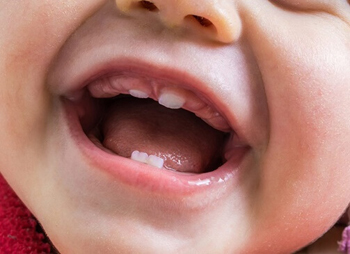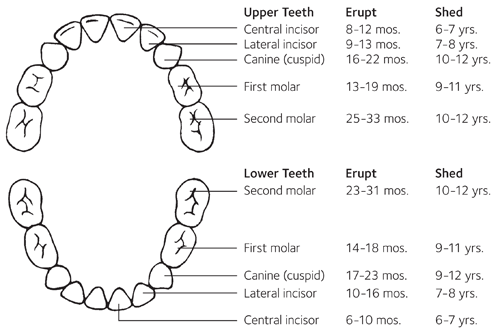Baby teeth are also known as primary, milk, deciduous teeth, are the ones that first appear in the mouth.
 Each person has two dentitions, primary and permanent. The primary is made of baby teeth, 20 to be exact. Ten of them are located in the upper jaw, ten in the lower one. They are not permanent and are lost at a certain age. Humans are diphyodonts which means that they have two sets of teeth. Baby teeth develop while the baby is still in the womb, and start erupting at around 6 months. Although the time of eruption is not the same for every child, there is a standardized chart of when the milk teeth should appear. These teeth have the same functions as permanent, including biting, chewing, speaking and more. Milk teeth have very important functions in the oral cavity. They are all located in the alveolar arch and guide the growth of the jaws. They also keep the space for permanent teeth.
Each person has two dentitions, primary and permanent. The primary is made of baby teeth, 20 to be exact. Ten of them are located in the upper jaw, ten in the lower one. They are not permanent and are lost at a certain age. Humans are diphyodonts which means that they have two sets of teeth. Baby teeth develop while the baby is still in the womb, and start erupting at around 6 months. Although the time of eruption is not the same for every child, there is a standardized chart of when the milk teeth should appear. These teeth have the same functions as permanent, including biting, chewing, speaking and more. Milk teeth have very important functions in the oral cavity. They are all located in the alveolar arch and guide the growth of the jaws. They also keep the space for permanent teeth.
Two of those ten in a jaw are central incisors and are located in the center front. The following two, placed right next to them are lateral incisors. The third pair is canines. The interesting thing about milk teeth is that there are no premolars in this dentition. Instead, kids have two pairs of molars, first and second. Eventually, the first permanent molar appears behind the second milk molar and the baby molars are replaced with permanent premolars. This is because the permanent teeth are bigger compared to baby teeth. When it comes to the anatomy, baby teeth are smaller, when they erupt have a significantly larger pulp chamber and shorter roots. The roots are spread, divergent. Between them, there should be a forming permanent tooth. Once the permanent ones start erupting, the roots of the baby teeth start resorbing.
Order Of Appearance:
This is definitely not how the primary teeth appear with every single child. There are a lot of variations, so it is normal for some to erupt earlier, other a bit later. As long as it’s all supervised by a dentist there shouldn’t be any problems. Central incisors appear between the age of 6 and 12 months. First, come the ones in the lower jaw, then the ones in the upper. When it comes to lateral, they are supposed to appear between 9 and 16 months. Canines erupt between 16 and 23 months. The first molar should be out between 13 and 19 months, while the second molar is the last one to appear in the time period between 22 and 33 months.

Hygiene:
It is very important for kids to know about good oral hygiene even from an early age. Although milk teeth are replaced, they should be treated the same as permanent. A very strict oral hygiene is required even from an early age so that the kid can form a habit. Brushing twice a day is one of the first steps. There are numerous kinds of toothpaste for kids, and toothbrushes as well. Those will make the whole process much easier.




